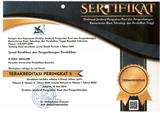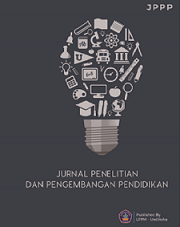Augmented Reality Based Competency Based Learning on Computer Network Learning in Vocational Education Vocational School
DOI:
https://doi.org/10.23887/jppp.v7i2.62263Keywords:
Augmented Reality, Competency Based Learning, Computer Networking , Vocational EducationAbstract
This research is motivated by the complexity of the subject matter of Computer Networks, the large number of teachers who teach these subjects with different backgrounds, and not all of them can be practised directly due to limited laboratory facilities, accompanied by a learning model that is not yet competency-based which also makes learning outcomes not optimal. This study aims to develop three-dimensional computer network learning media using Augmented Reality Assembly Edu software in vocational education. This type of research is created using the ADDIE model, which includes analysis, design, development, implementation, and evaluation. Collection methods using observation and interviews. The data collection instrument used a questionnaire. Data analysis techniques using qualitative and quantitative descriptive analysis. The results showed that Competency-based learning-based Augmented Reality media, validated by a team of media experts and material experts, was very valid. In contrast, students stated well because this media made it easier to understand the material and motivated them to try and learn. It was concluded that Competency-based learning-based Augmented Reality media could be used in learning.
References
Ambiyar, Waskito, Rojiyyah, EFendi, R., & Wulandari, R. A. (2023). Design of Flipped Classroom Learning in Vocational Education to improve HOT Skills in the era of the Industrial Revolution 4.0. KnE Social Sciences, 2023, 106–115. https://doi.org/10.18502/kss.v8i4.12888. DOI: https://doi.org/10.18502/kss.v8i4.12888
Arnaiz-Sánchez, P., De Haro-Rodríguez, R., Caballero, C. M., & Martínez-Abellán, R. (2023). Barriers to Educational Inclusion in Initial Teacher Training. Societies, 13(2). https://doi.org/10.3390/soc13020031. DOI: https://doi.org/10.3390/soc13020031
Bradley, E. G., & Kendall, B. (2014). A Review of Computer Simulations in Teacher Education. Journal of Educational Technology Systems, 43(1). https://doi.org/10.2190/et.43.1.b. DOI: https://doi.org/10.2190/ET.43.1.b
Branch, R. M. (2010). Instructional design: The ADDIE approach. In Instructional Design: The ADDIE Approach. https://doi.org/10.1007/978-0-387-09506-6. DOI: https://doi.org/10.1007/978-0-387-09506-6
Chen, C. C., Chen, H. R., & Wang, T. Y. (2022). Creative Situated Augmented Reality Learning for Astronomy Curricula. Educational Technology and Society, 25(2). https://www.jstor.org/stable/48660130.
Efendi, R., & Ali, G. (2019). Analisis Multi Criterion Decision Making Pada Decision Support System Untuk Pengambilan Keputusan Penentuan Penerima Beasiswa. JOISIE (Journal Of Information), 1(1). https://doi.org/10.35145/joisie.v1i1.384. DOI: https://doi.org/10.35145/joisie.v1i1.384
Efendi, R., Jama, J., & Yulastri, A. (2019a). Effectiveness of Competency Based Learning Models in Computer Networks Learning. International Journal of Educational Dynamics, 1(2). https://doi.org/10.24036/ijeds.v1i2.155.
Efendi, R., Jama, J., & Yulastri, A. (2019b). Development of Competency Based Learning Model in Learning Computer Networks. Journal of Physics: Conference Series, 1387(1). https://doi.org/10.1088/1742-6596/1387/1/012109. DOI: https://doi.org/10.1088/1742-6596/1387/1/012109
Efendi, R., Rojiyyah, I., & Wulandari, R. A. (2021). Need Analysis for Development of Web-Based Flipped Classroom Learning Models in Vocational Education. In Journal of Physics: Conference Series, 1764(1), 012103. https://doi.org/10.1088/1742-6596/1764/1/012103. DOI: https://doi.org/10.1088/1742-6596/1764/1/012103
Eldokhny, A. A., & Drwish, A. M. (2021). Effectiveness of Augmented Reality in Online Distance Learning at the Time of the COVID-19 Pandemic. International Journal of Emerging Technologies in Learning, 16(9). https://doi.org/10.3991/ijet.v16i09.17895. DOI: https://doi.org/10.3991/ijet.v16i09.17895
Frydenberg, M. E., & Andone, D. (2011). Learning for 21st Century Skills. IEEE’s International Conference on Information Society, 314–318. https://doi.org/10.1109/i-Society18435.2011.5978460. DOI: https://doi.org/10.1109/i-Society18435.2011.5978460
Huang, T. K., Yang, C. H., Hsieh, Y. H., Wang, J. C., & Hung, C. C. (2018). Augmented reality (AR) and virtual reality (VR) applied in dentistry. Kaohsiung Journal of Medical Sciences, 34(4), 243–248. https://doi.org/10.1016/j.kjms.2018.01.009. DOI: https://doi.org/10.1016/j.kjms.2018.01.009
Hussain, F. (2023). Pedagogy in Universiti Teknologi MARA (UiTM): Teaching and Learning Civil Procedure II. Malaysian Journal of Social Sciences and Humanities (MJSSH), 8(1). https://doi.org/10.47405/mjssh.v8i1.1943. DOI: https://doi.org/10.47405/mjssh.v8i1.1943
Krüger, J. M., & Bodemer, D. (2022). Application and Investigation of Multimedia Design Principles in Augmented Reality Learning Environments. Information (Switzerland), 13(2). https://doi.org/10.3390/info13020074. DOI: https://doi.org/10.3390/info13020074
Liu, M., & Mu, X. (2022). Analysis of Computer Network Technology on New Media Problem-Based Learning (PBL) Teaching Method. Wireless Communications and Mobile Computing, 2022. https://doi.org/10.1155/2022/3235078. DOI: https://doi.org/10.1155/2022/3235078
Lubis, A. H., & Wangid, M. N. (2019). Augmented Reality-assisted Pictorial Storybook: Media to Enhance Discipline Character of Primary School Students. Mimbar Sekolah Dasar, 6(1), 11–20. https://doi.org/10.17509/mimbar-sd.v6i1.16415. DOI: https://doi.org/10.53400/mimbar-sd.v6i1.16415
Majid, S. N. A., & Salam, A. R. (2021). A Systematic Review of Augmented Reality Applications in Language Learning. International Journal of Emerging Technologies in Learning, 16(10). https://doi.org/10.3991/ijet.v16i10.17273. DOI: https://doi.org/10.3991/ijet.v16i10.17273
Maurer, H. (2017). Problems and solutions for using computer (networks) for education. Journal of Research in Innovative Teaching & Learning, 10(1). https://doi.org/10.1108/jrit-08-2016-0002. DOI: https://doi.org/10.1108/JRIT-08-2016-0002
Mubai, A., Rukun, K., Tasrif, E., & Huda, A. (2020). Augmented Reality (AR) - Based Learning Media on the Subject of Computer Network Installation. Jurnal Pendidikan Dan Pengajaran, 53(July), 213–226. https://doi.org/10.23887/jpp.v53i2.25943.
Nidhom, A. M., Putra, A. B. N. R., Smaragdina, A. A., Dyah, K. N. G., Habibi, M. A., & Yunos, J. M. (2022). The Integration of Augmented Reality into MOOC’s in Vocational Education to Support Education 3.0. International Journal of Interactive Mobile Technologies, 16(3). https://doi.org/10.3991/IJIM.V16I03.28961. DOI: https://doi.org/10.3991/ijim.v16i03.28961
Noll, C., von Jan, U., Raap, U., & Albrecht, U.-V. (2017). Mobile Augmented Reality as a Feature for Self-Oriented, Blended Learning in Medicine: Randomized Controlled Trial. JMIR MHealth and UHealth, 5(9), e139. https://doi.org/10.2196/mhealth.7943. DOI: https://doi.org/10.2196/mhealth.7943
Pujiastuti, H., & Haryadi, R. (2023). Higher-Order Thinking Skills Profile of Islamic Boarding School Students on Geometry through the STEM–based Video Approach. International Journal of STEM Education for Sustainability, 3(1). https://doi.org/10.53889/ijses.v3i1.135. DOI: https://doi.org/10.53889/ijses.v3i1.135
Qodr, T. S., Efendi, A., & Musadad, A. A. (2021). Opportunities for Using Smartphones in the Digital Era to Facilitate Students in Learning Sociology in High Schools. Journal of Education Technology, 5(2), 263–271. https://doi.org/10.23887/jet.v5i2.34806. DOI: https://doi.org/10.23887/jet.v5i2.34806
Rukayah, Daryanto, J., Atmojo, I. R. W., Ardiansyah, R., Saputri, D. Y., & Salimi, M. (2022). Augmented Reality Media Development in STEAM Learning in Elementary Schools. Ingenierie Des Systemes d’Information, 27(3). https://doi.org/10.18280/isi.270313. DOI: https://doi.org/10.18280/isi.270313
Segec, P., Moravcik, M., Kontsek, M., Papan, J., Uramova, J., & Yeremenko, O. (2019). Network virtualization tools-analysis and application in higher education. ICETA 2019 - 17th IEEE International Conference on Emerging ELearning Technologies and Applications, Proceedings, November, 699–708. https://doi.org/10.1109/ICETA48886.2019.9040148. DOI: https://doi.org/10.1109/ICETA48886.2019.9040148
Septiani, A. N. S. I. (2020). Development of Interactive Multimedia Learning Courseware to Strengthen Students’ Character. European Journal of Educational Research, 9(3), 1267–1279. https://doi.org/10.12973/eu-jer.9.3.1267. DOI: https://doi.org/10.12973/eu-jer.9.3.1267
Setiawardhani, R. T. (2013). Pembelajaran elektronik (e-learning) dan internet dalam rangka mengoptimalkan kreativitas belajar siswa. Jurnal Ilmiah Pendidikan Ekonomi Unswagati, 1(2), 82–96. http://fkip-unswagati.ac.id/ejournal/index.php/edunomic/article/download/21/20.
Shahroom, A. A., & Hussin, N. (2018). Industrial Revolution 4.0 and Education. International Journal of Academic Research in Business and Social Sciences, 8(9). https://doi.org/10.6007/ijarbss/v8-i9/4593. DOI: https://doi.org/10.6007/IJARBSS/v8-i9/4593
Sung, N. J., Ma, J., Choi, Y. J., & Hong, M. (2019). Real-time augmented reality physics simulator for education. Applied Sciences (Switzerland), 9(19). https://doi.org/10.3390/app9194019. DOI: https://doi.org/10.3390/app9194019
Tuwoso, Putra, A. B. N. R., & Muhammad, A. K. Bin. (2021). The Innovation of Augmented Reality Learning Media with Interactive Component Model to Improve Special Ability of Vocational Education Knowledge in the Digital Era. International Journal of Interactive Mobile Technologies, 15(21). https://doi.org/10.3991/ijim.v15i21.24833. DOI: https://doi.org/10.3991/ijim.v15i21.24833
Uriarte-Portillo, A., Ibáñez, M. B., Zataraín-Cabada, R., & Barrón-Estrada, M. L. (2022). Higher Immersive Profiles Improve Learning Outcomes in Augmented Reality Learning Environments. Information (Switzerland), 13(5). https://doi.org/10.3390/info13050218. DOI: https://doi.org/10.3390/info13050218
Warschauer, M., Turbee, L., & Roberts, B. (1996). Computer learning networks and student empowerment. System, 24(1). https://doi.org/10.1016/0346-251X(95)00049-P. DOI: https://doi.org/10.1016/0346-251X(95)00049-P
Washbrooke, S. (2023). Teaching and learning with innovative technologies and practices at primary school level. Pacific Journal of Technology Enhanced Learning, 5(1). https://doi.org/10.24135/pjtel.v5i1.165. DOI: https://doi.org/10.24135/pjtel.v5i1.165
Widiaty, I., Ana, A., Suciati, Kuswardhana, D., Achdiani, Y., & Mubaroq, S. R. (2021). Development of augmented reality technology in vocational school: A socio-technical curriculum framework. Journal of Engineering Science and Technology, 16(4). http://jestec.taylors.edu.my/Vol 16 Issue 4 August 2021/16_4_24.pdf.
Yassir, M., Syam, H., & Nur, H. (2022). Higher Order Thinking Skills (HOTs) based Assessment for Learning: A Model for Computer Networks Learning in Vocational School. Asian Journal of Applied Sciences, 10(1). https://doi.org/10.24203/ajas.v10i1.6876. DOI: https://doi.org/10.24203/ajas.v10i1.6876
Ye, P., & Xu, X. (2023). A case study of interdisciplinary thematic learning curriculum to cultivate “4C skills.” Frontiers in Psychology, 14. https://doi.org/10.3389/fpsyg.2023.1080811. DOI: https://doi.org/10.3389/fpsyg.2023.1080811
Downloads
Published
How to Cite
Issue
Section
License
Copyright (c) 2023 Raimon Efendi, Gunawan Ali, Wulan Andang Purnomo, Ratih Agustin Wulandari, Iskandar Iskandar

This work is licensed under a Creative Commons Attribution-ShareAlike 4.0 International License.
Authors who publish with the Jurnal Penelitian dan Pengembangan Pendidikan agree to the following terms:
- Authors retain copyright and grant the journal the right of first publication with the work simultaneously licensed under a Creative Commons Attribution License (CC BY-SA 4.0) that allows others to share the work with an acknowledgment of the work's authorship and initial publication in this journal.
- Authors are able to enter into separate, additional contractual arrangements for the non-exclusive distribution of the journal's published version of the work (e.g., post it to an institutional repository or publish it in a book), with an acknowledgment of its initial publication in this journal.
- Authors are permitted and encouraged to post their work online (e.g., in institutional repositories or on their website) prior to and during the submission process, as it can lead to productive exchanges, as well as earlier and greater citation of published work. (See The Effect of Open Access)







